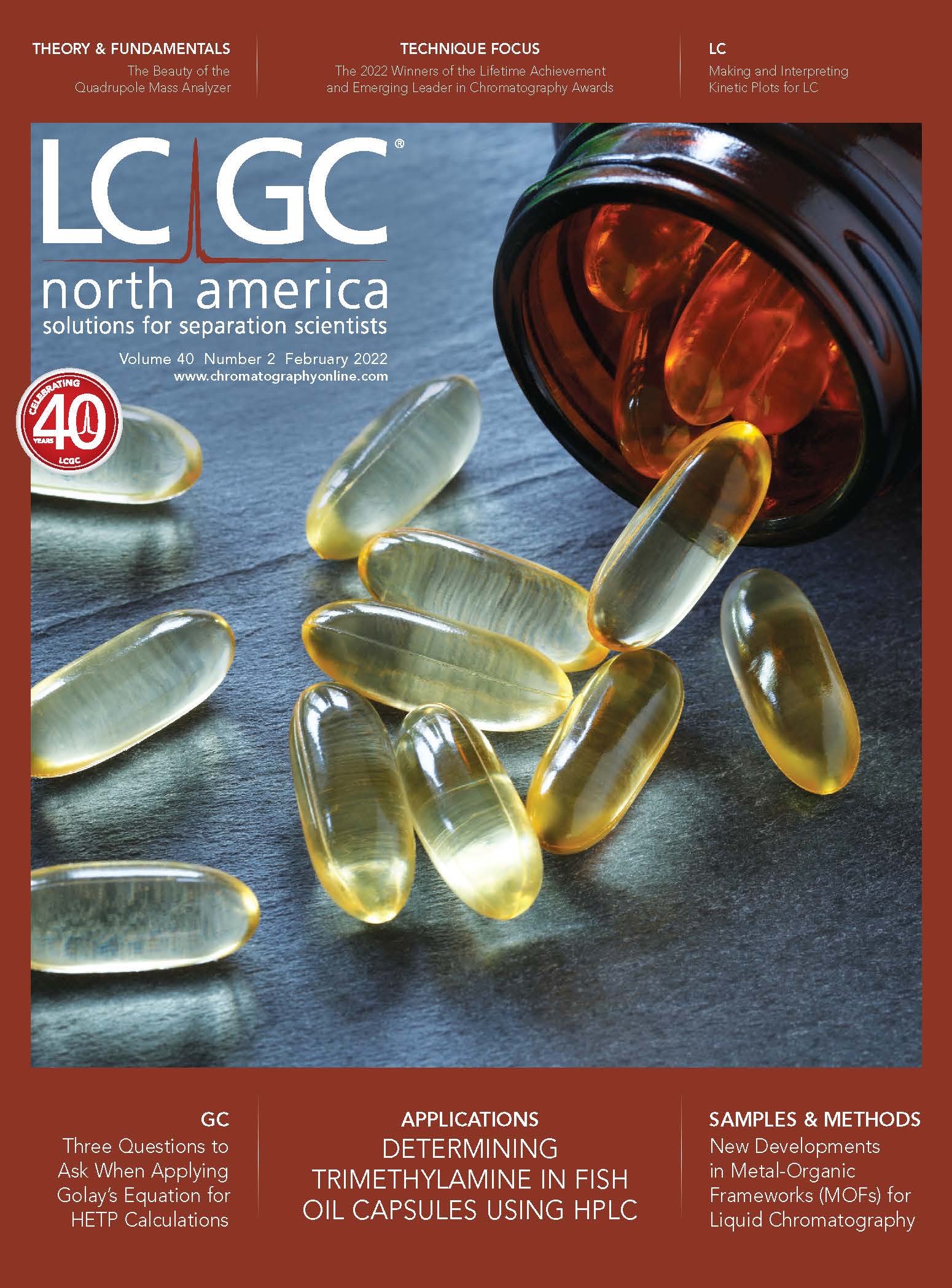The Current Status of Metal-Organic Frameworks (MOFs) for Use in Liquid Chromatography
Metal-organic frameworks (MOFs) are self-assembled combinations of metals and inorganic ligands that result in a relatively young class of highly ordered, porous materials. Because of the number of structural and chemical possibilities, high surface area, controlled pore volume, and favorable thermal properties, MOFs are being investigated in several fields, including chromatography. Because of the enormous interest in a 2018 “Column Watch” article on the subject and the high level of research in the field, this article explores recent (2019–present) activity specifically toward the application of MOFs for liquid chromatography (LC).
Early investigations utilizing metal-organic frameworks (MOFs) for liquid chromatography (LC) were discussed in a 2018 issue of this column series (1). As one of my most widely read contributions and given the large amount of research that continues to be observed in the field, it seems prudent to provide a current review and comment on advancements in the field since 2018.
Research on the utilization of MOFs for chromatography include applications in sample preparation, gas chromatography (GC), and LC, among others. In monitoring activity over the past several years, the majority of publications within the chromatography realm continue to focus on materials for sample preparation, with fewer focusing on dynamic chromatography. With that being said, interest in MOF-enabled LC and GC are clearly on the rise. This paper focuses on the newest developments in LC.
One of the major issues noted regarding the use of MOFs for LC in the 2018 Column Watch paper was that the generated particles are often irregularly shaped and possess large particle size distributions. These qualities result in poor chromatographic efficiency when packed in LC columns. At that time efforts to build MOFs on silica particles in an attempt to utilize the former’s controlled particle size, shape, and uniformity were just starting. Much of the research conducted since then has built upon such initial efforts, including the control and distribution of the MOF material. These efforts include improved synthesis and control of the MOF distribution on the silica surface, improved understanding of the role of the silica substrate, as well as the addition of other materials, such as polymers, to enhance the utility, robustness, and reproducibility of resulting composites.
This column describes some of the more pertinent research conducted over the past few years. The contents are by no means meant to be exhaustive, but represent just a few of the interesting trends toward the development of MOFs for LC.
Discussion
Recent Efforts to Improve MOF@Silica Composites
Several early attempts at developing MOF@ silica composites (note that in this work the convention of “shell material” @ “core material” is used to describe composite construction) resulted in improved efficiency over the native MOF particles but still fell short of modern standards. It is expected that this is largely because of uncontrolled growth of the MOF layer on the silica substrate. An attempt to improve the efficiency of MOF@silica composites was reported by Si and coworkers (2).
By controlling the distribution of MOF growth on the surface of silica through first modifying the surface with 2-methylimidazole to seed the reaction prior to the addition of the metal ions, the authors reported moderate, but significant improvements in performance as compared to previous synthetic methods.
Another attempt at improving MOF@ silica composites was published by Qu and others (3). In this method, the formation of zeolite imidazolate framework-8 (ZIF-8) on the surface of the silica was kinetically controlled through modifying the dimethylformamide (DMF) to methanol solvent ratio employed in the synthesis. The authors used an efficient separation of xylene isomers to demonstrate the applicability of their synthetic approach. Another “kinetically controlled” MOF@silica composite was separately reported by the Qu team where HKUST-1 nanocrystals (1,3,5-benzenetricarboxylate and copper(II)) were confined in the pores of the silica. This reaction was also controlled by manipulating the solvent system utilized in the reaction (4).
UiO-66 is a popular MOF that has been shown to be effective in various separation device formats. UiO-66 is based on a ZrO6(OH)2 octahedron and 1,4-benzenedicarboxylate (BDC) linkers. Its cubic three-dimensional (3D)-pore structure consists of an array of octahedral cavities that have a diameter of 1.1 nm, and tetrahedral cavities with a diameter of 0.8 nm (5). In another example of “seeding”, to better control the growth of the MOF, Gao and coworkers carried out the synthesis of UiO-66@silica composites by combining a carboxylate-terminated silica, ZrCl4, and terephthalic acid. The authors compared a heated stirring procedure to the more common solvothermal process. Here, the use of the composite MOF materials under more controlled synthetic conditions were found to provide superior chromatographic efficacy compared to columns packed with UiO-66 crystals alone (5).
A layer-by-layer synthetic approach was reported by Ehrling and others (6). In their work, both a relatively hydrophilic MOF [MIL-101(Fe)-NH2 (FeCl3/2-aminoterephthalic acid)] and a relatively hydrophobic MOF [UiO-67 (Zr6O4(OH)4/4,4’-biphenyldicarboxylate)] were employed to produce core-shell silica composite particles for application as stationary phases for LC. The layer-by-layer method consisted of immobilizing the metal ions onto the surface of the silica particles followed by exposure to the acid linkers with washings taking place after each step. The cycles can be repeated until the desired materials are obtained. The authors reported excellent separations of various classes of compounds under normal phase conditions employing columns using MOF@silica composites prepared in this manner. In another layer-by-layer approach, Liu and coworkers synthesized MOF-74@silica composites and subsequently packed efficient LC columns with these materials (7). In this case, MOF-74 consisted of 2,5-dihydroxyterephthalic acid as the organic ligand and nickel as the metal center. The authors provide several chromatographic applications demonstrating hydrophilic and hydrophobic character as well as alternative selectivity from other MOF composites (7).
Building 3D MOFs on the surface of silica may result in a certain amount of disorder. For example, the MOF crystals may be randomly placed and various sized crystal structures may result. The net impact is the potential for poor efficiency in dynamic chromatography. One report intended to solve this issue proposed using two-dimensional (2D) or nanosheets of MOFs when building the MOF@silica composite materials (8). According to the authors, a 3D MOF (MOF-FDM-23) was first prepared then treated via ultrasound to produce 2D structures that were then assembled onto a silica surface. Subsequent analysis of the 2D MOF-FDM-23@silica column demonstrated superior efficiency in comparison to the 3D MOF-based stationary phases tested.
The synthetic control of the MOF formation, as noted above, impacts the overall efficiency of the composite material. However, the silica substrate can also have bearing on the final results. Wei found that the pore size of the silica substrate can have a significant impact on the uniformity of ZIF-8 MOFs that are grown on them. The authors reported that wide-pore silicas provided improved uniformity of the ZIF-8 and that the uniformity could also be enhanced further by modifying reaction solvent systems (here, DMF:methanol ratios). The improved efficiencies were demonstrated through several chromatographic applications (9).
Studies Incorporating Additional Polymer Materials
The incorporation of additional components to MOF@silica composites, such as polymers, has also been a subject of study. Si and coworkers reported on an efficient synthesis of core-shell composite material built upon silica microspheres that were modified with both the metal organic framework (MOF-235) and polyethylene glycol polymer (PEG) (10). MOF-235 is constructed from iron (III) chloride and terephthalic acid. The MOF-235@PEG@ silica stationary phase was shown to provide both hydrophilic and hydrophobic character with separation properties superior to the MOF-235@silica composite also studied in this paper. The authors investigated several parameters, such as pH, buffer concentration, and the ratio of organic modifier in the mobile phase, to support the retention mechanisms claims. Another publication supporting the addition of polymers to MOF@silica composites was also provided by Si and others. In that study, polyvinylpyrrolidone was synergistically immobilized with a nickel organic framework onto a silica surface. The resulting Ni-MOF-PVP@silica composite was shown to exhibit both hydrophilic and hydrophobic character as well as some enhanced performance owing to the PVP modification (11). In a similar publication, the same group discussed the modification of a MOF-235@silica composite with PVP via a modified process documented in the literature (10), stating that the PVP helps to suppress silanol activity, enhances composite material robustness, and improves the water compatibility of the original MOF-based stationary phases (12).
Other Interesting Finds
An article focused on the use of MOFs for preparative work was interesting. The authors utilized MIL-53 (aluminum terephthalate) as a substrate to understand the adsorption isotherms of m-cresol and p-cresol. The studies on the adsorption process for the analytes indicated a complex, multistage process. Although the process was complicated to model, purification was effective (13). It is highly possible that MOF-based materials will find their way into preparative processes in the future.
MIL-53(Al) is typically prepared from trivalent aluminum (aluminum nitrate) and terephthalic acid via a solvothermal process. In an interesting report from Aqel and coworkers, the authors used polyethylene terephthalate (PET) bottles as their “green” terephthalic acid source for the MOF-53(Al) synthesis and demonstrated equivalent separation performance to the traditional approach using standard chemical sources of terephthalic acid (14). Perhaps this will inspire other innovative “green” approaches for MOF synthesis. Because of the sheer number of developments of the field of MOFs, experimental exploration to find the right MOF for an application, or design the right material for a given purpose, is becoming more difficult. As with other “big data” issues, computational methods are likely to assist greatly. Yan and others recently published an interesting review intended to highlight current research in this field as related to MOFs. High throughput screening and machine-learning assisted high throughput screening methods are discussed (15).
Chiral
As mentioned in the 2018 “Column Watch” article, the use of MOFs for chiral separations is of great interest. There have been a considerable amount of articles published over the past few years, focusing on chiral MOFs and their MOF@silica composites for use in LC. There has been enough activity in this realm that the subject likely warrants its own independent treatment, which is planned for a future installment. For those interested in delving into this subject sooner, a recent review by Taima-Mancera and Pino provides a good start (16).
Conclusions
Interest in MOFs for application in LC continues to rise. Early issues packing efficient LC columns arising from the irregular shape and large particle size distribution of native MOFs were initially improved through the development of MOF@silica composites. These composites take advantage of the controlled particle size distribution of silica and the improvement in efficiency this characteristic brings. However, simply building the crystalline MOF structure on the surface of the silica still limits the efficiency of the resultant materials. Over the past several years, most of the effort has been focused on improving the synthetic approaches used to prepare MOF@silica composites. The careful seeding of the silica surface with either the organic ligand or the metal center has been used to better distribute the growth of the MOF evenly across the surface of the substrate. Several researchers have demonstrated improvements in efficiency through a “layer-by-layer” approach toward building the MOF structures. In almost all cases, careful control of reaction solvent conditions were reported to impact the efficiency of the final materials. Studies intended to better understand the impact the properties of the silica substrate have on the eventual MOF@ silica composite are also expected to result in improved materials.
Although MOF-based materials for dynamic LC separations are not commercially available at this point, the rapid development and the large number of research efforts observed in this field indicate that this may not be far off from being realized.
Acknowledgments
The author would like to thank Xueyi Zhang, Assistant Professor in the Department of Chemical Engineering at The Pennsylvania State University in University Park; Daniel Shollenberger, Research Scientist III at Restek Corporation; and William G. Van Der Sluys, Assistant Teaching Professor of Chemistry, The Pennsylvania State University, College at Altoona, for their review of the article and their insightful conversations on the topic of MOFs for chromatography.
References
(1) D.S. Bell, LCGC N. Am. 36(6), 352–354 (2018).
(2) T. Si, et al., Anal. Chim. Acta. 1183, 338942 (2021).
(3) Q. Qu, et al., J. Chromatogr. A. 1505, 63–68 (2017).
(4) Q. Qu, et al., Microchim. Acta. 184(10), 4099–4106 (2017).
(5) B. Gao, et al., Chin. J. Chem. Eng. 27(4), 818–826 (2019).
(6) S. Ehrling, et al., Microporous Mesoporous Mater. 263, 268–274 (2018).
(7) M. Liu, et al., J. Chromatogr. B. 1163, 122506 (2021).
(8) T. Si, et al., Talanta 222, 121603 (2021).
(9) Q. Wei, et al., Microporous Mesoporous Mater. 288, 109574 (2019).
(10) T. Si, et al., Anal. Chim. Acta. 1143, 181–188 (2021).
(11) T. Si, et al., Talanta 232, 122459(2021).
(12) T. Si, et al., Microchim. Acta. 188(3) (2021).
(13) S. Li, B. Peng, and S. Wang, J. Chromatogr. A. 1611, 460599 (2020).
(14) A. Aqel, et al., J. Chromatogr. A. 1638, 461857 (2021).
(15) Y. Yan, et al., Comput. Mater. Sci. 193, 110383 (2021).
(16) I. Taima-Mancera and V. Pino, J. Chromatogr. Open 1, 100002 (2021).
ABOUT THE AUTHOR
David S. Bell is a Research Fellow at Restek Corporation. He also serves on the Editorial Advisory Board for LCGC and is the Editor for “Column Watch.” Over the past 20+ years, he has worked directly in the chromatography industry, focusing his efforts on the design, development, and application of chromatographic stationary phases to advance gas chromatography, liquid chromatography, and related hyphenated techniques. Direct correspondence to: LCGCedit@mmhgroup.com


Common Challenges in Nitrosamine Analysis: An LCGC International Peer Exchange
April 15th 2025A recent roundtable discussion featuring Aloka Srinivasan of Raaha, Mayank Bhanti of the United States Pharmacopeia (USP), and Amber Burch of Purisys discussed the challenges surrounding nitrosamine analysis in pharmaceuticals.
Extracting Estrogenic Hormones Using Rotating Disk and Modified Clays
April 14th 2025University of Caldas and University of Chile researchers extracted estrogenic hormones from wastewater samples using rotating disk sorption extraction. After extraction, the concentrated analytes were measured using liquid chromatography coupled with photodiode array detection (HPLC-PDA).














